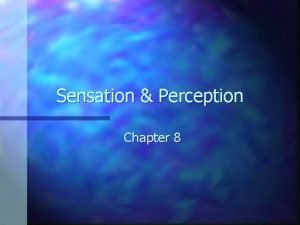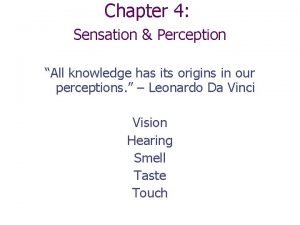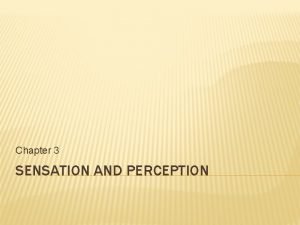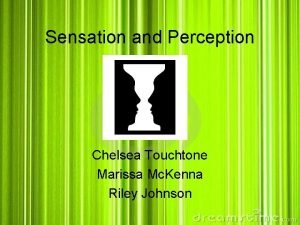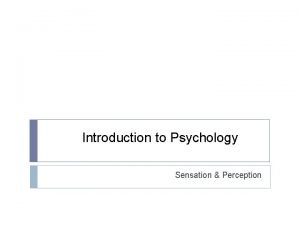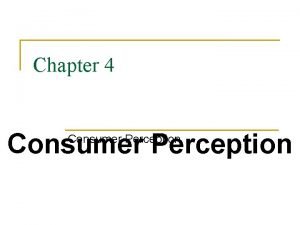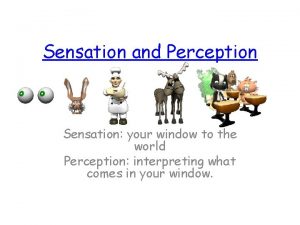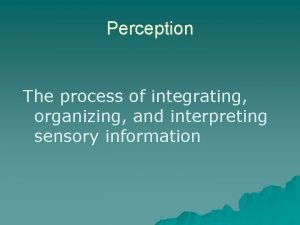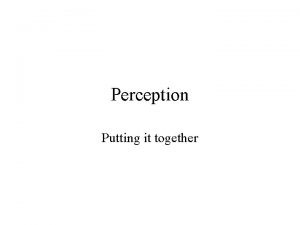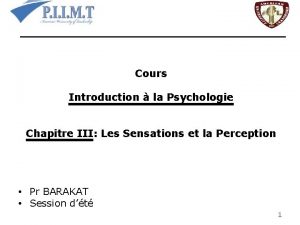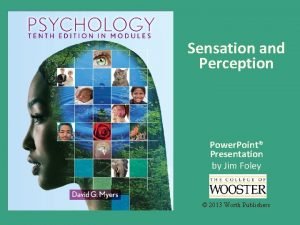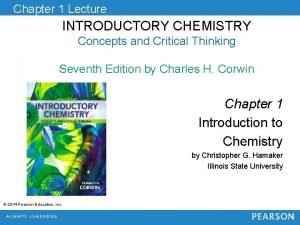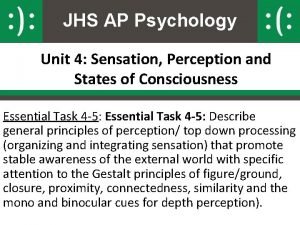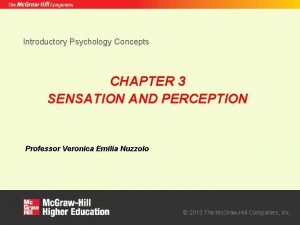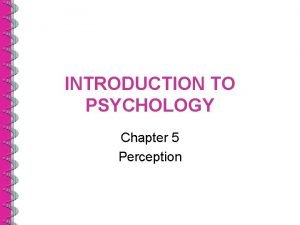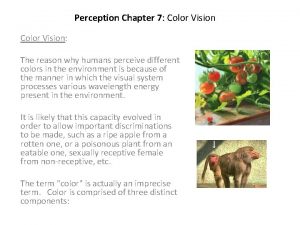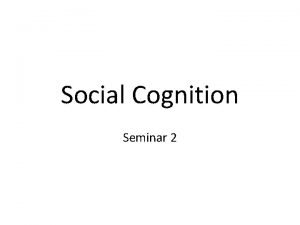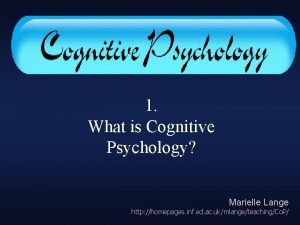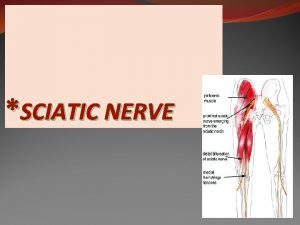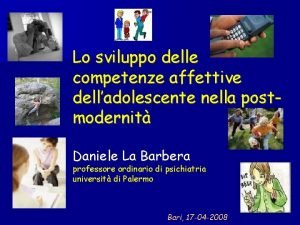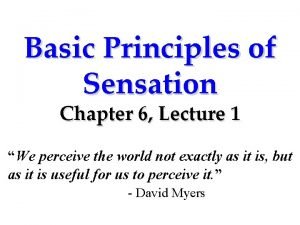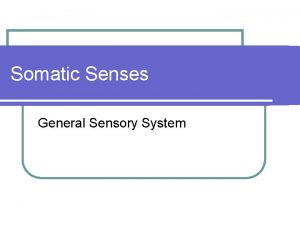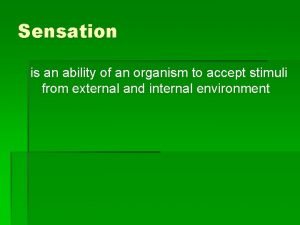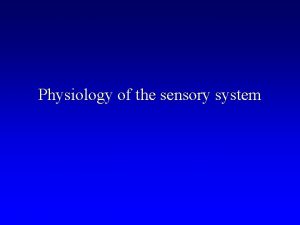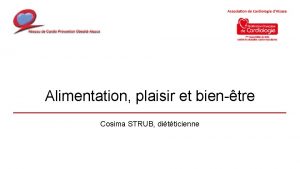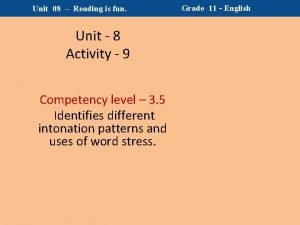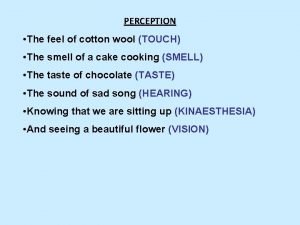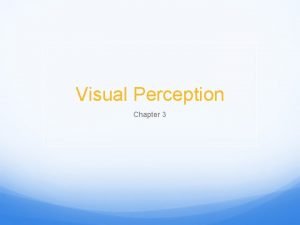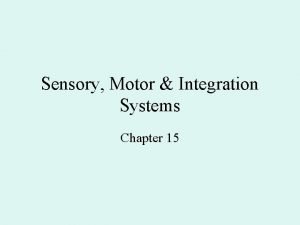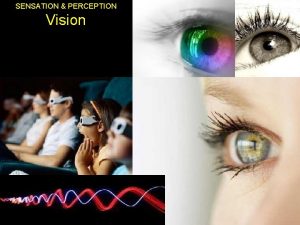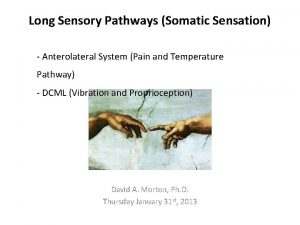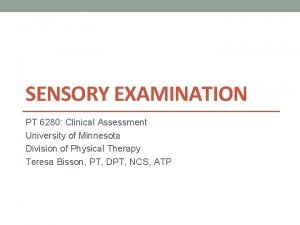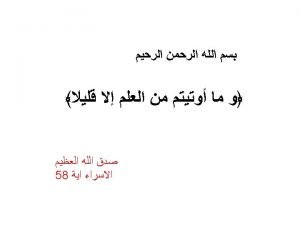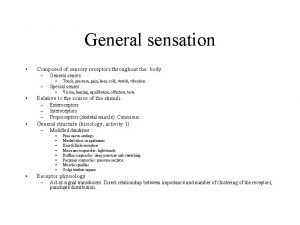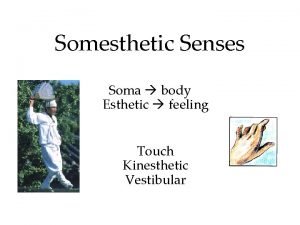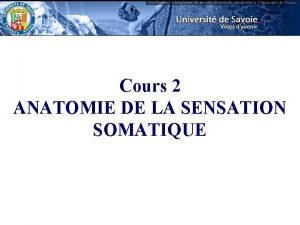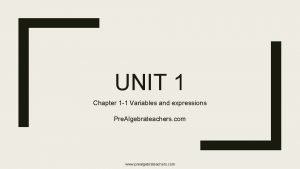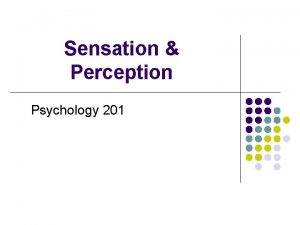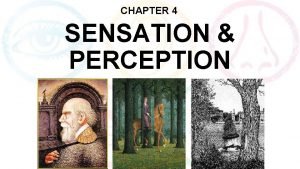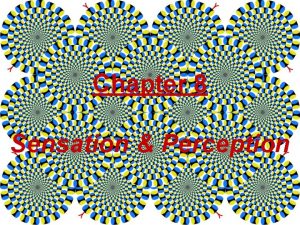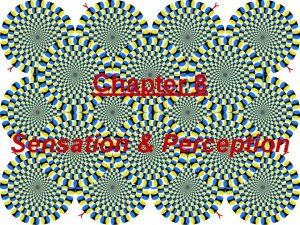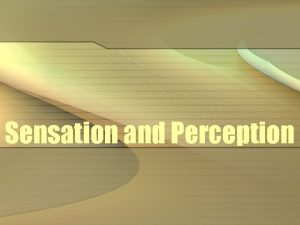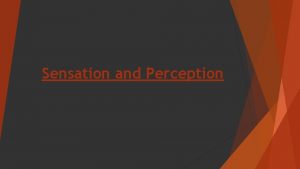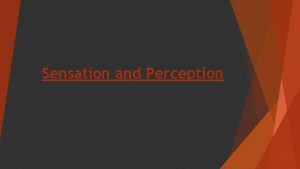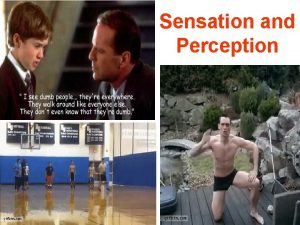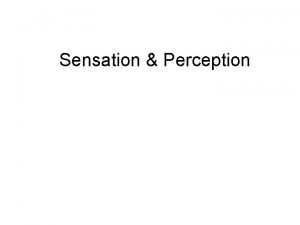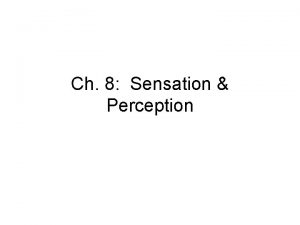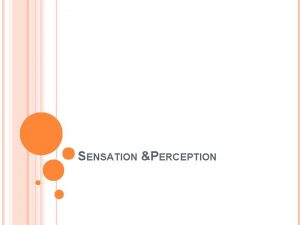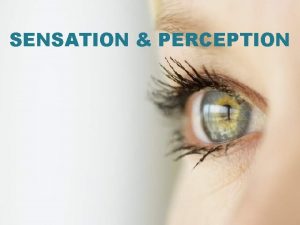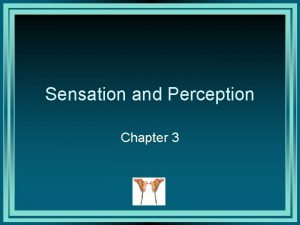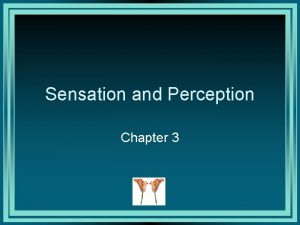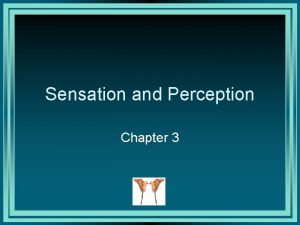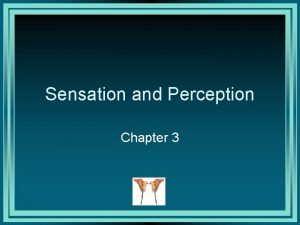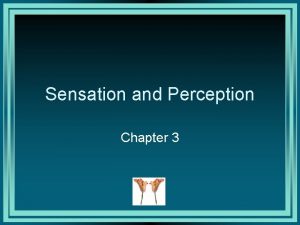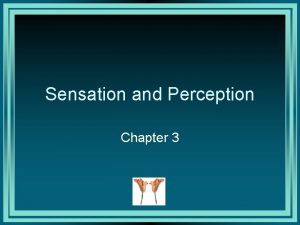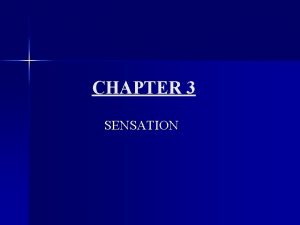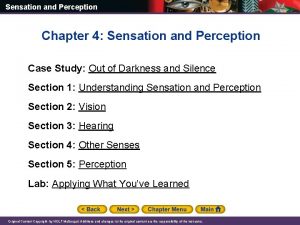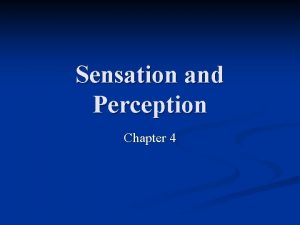Introductory Psychology Concepts CHAPTER 3 SENSATION AND PERCEPTION



























































- Slides: 59

Introductory Psychology Concepts CHAPTER 3 SENSATION AND PERCEPTION Professor Veronica Emilia Nuzzolo © 2013 The Mc. Graw-Hill Companies, Inc.

Sensation: The activation of the sense organs by a source of physical energy. Human sensory capabilities go well beyond the basic five senses (sight, sound, taste, smell, touch). • • • We are sensitive not merely to touch but to a considerably wider set of stimuli—pain, pressure, temperature, vibration. Vision has two subsystems—relating to day and night vision. The ear is responsive to information that allows us not only to hear but also to keep our balance. © 2013 The Mc. Graw-Hill Companies, Inc. 3 -2

Sensory Receptors: Specialized neurons activated by stimuli. Ganglion Amacrine Bipolar Horizontal cells Cone Rod Back of eye Light Blind spot (optic disk) Optic nerve fibers (to brain) Ganglion cell layer Bipolar cell layer Photoreceptors in the retina, the rods and cones, synapse with bipolar cells, which in turn synapse with ganglion cells whose axons form the optic nerve. © 2013 The Mc. Graw-Hill Companies, Inc. 3 -3

Thresholds Absolute Threshold • • Defined as the lowest intensity at which a stimulus can be detected 50 percent of the time. The lower the absolute threshold, the greater the sensitivity. Approximate Absolute Thresholds for Humans Sensory Modality Absolute Threshold Vision Candle flame seen at 30 miles on a clear, dark night Hearing Tick of a watch under quiet conditions at 20 feet Taste 1 teaspoon of sugar in 20 gallons of water Smell 1 drop of perfume diffused into the entire volume of a large apartment Touch Wing of a fly or bee falling on a person’s cheek from a distance of 1 centimeter Source: Based on Galanter, 1962. © 2013 The Mc. Graw-Hill Companies, Inc. 3 -4

Thresholds Just Noticeable Difference (JND) • • • The smallest difference between two stimuli that people can perceive 50 percent of the time. Weber’s law states that the difference threshold, or JND, is directly proportional to the magnitude of the stimulus with which the comparison is being made and can be expressed as a Weber fraction. Weber’s law breaks down at extremely high and low intensities of stimulation, but holds up reasonably well within the most frequently encountered range. © 2013 The Mc. Graw-Hill Companies, Inc. 3 -5

Thresholds Signal Detection Theory • • Concerned with the factors that influence sensory judgments. There is no single point on the intensity scale that separates stimulus detection from nondetection. People set their own decision criterion, a standard of how certain they must be that a stimulus is present before they will say they detect it. Decision criterion can change, depending on such factors as fatigue, expectation, and the potential significance of the stimulus. © 2013 The Mc. Graw-Hill Companies, Inc. 3 -6

Thresholds Subliminal Stimuli • • A subliminal stimulus is one that is so weak or brief that although it is received by the senses, it cannot be perceived consciously. Research suggests that subliminal stimuli may affect subtle phenomena, such as perceptions and attitudes. (Greenwald & Banaji, 1995) • • In one study, college students who were exposed to subliminal presentations of aggressively toned words like “hit” and “attack” later judged ambiguous behaviors of others as more aggressive. They were also more likely to behave aggressively than were participants who had been exposed to subliminal nonaggressive words. (Todorov & Bargh, 2002) © 2013 The Mc. Graw-Hill Companies, Inc. 3 -7

Introductory Psychology Concepts : Perception Giving Meaning to Sensation. The sorting out, interpretation, analysis, and integration of stimuli by the sense organs and brain. 1. Stimulus is received by sensory receptors. Sensation © 2013 The Mc. Graw-Hill Companies, Inc. Perception 3 -8

Introductory Psychology Concepts : Perception Giving Meaning to Sensation. The sorting out, interpretation, analysis, and integration of stimuli by the sense organs and brain. 1. Stimulus is received by sensory receptors. Sensation Perception 2. Receptors translate stimulus properties into nerve impulses (transduction). © 2013 The Mc. Graw-Hill Companies, Inc. 3 -9

Introductory Psychology Concepts : Perception Giving Meaning to Sensation. The sorting out, interpretation, analysis, and integration of stimuli by the sense organs and brain. 1. Stimulus is received by sensory receptors. 3. Feature detectors analyze stimulus features. Sensation Perception 2. Receptors translate stimulus properties into nerve impulses (transduction). © 2013 The Mc. Graw-Hill Companies, Inc. 3 -10

Introductory Psychology Concepts : Perception Giving Meaning to Sensation. The sorting out, interpretation, analysis, and integration of stimuli by the sense organs and brain. 1. Stimulus is received by sensory receptors. 3. Feature detectors analyze stimulus features. Sensation Perception 2. Receptors translate stimulus properties into nerve impulses (transduction). © 2013 The Mc. Graw-Hill Companies, Inc. 4. Stimulus features are reconstructed into neural representation. 3 -11

Introductory Psychology Concepts : Perception Giving Meaning to Sensation. The sorting out, interpretation, analysis, and integration of stimuli by the sense organs and brain. 1. Stimulus is received by sensory receptors. 3. Feature detectors analyze stimulus features. 5. Neural representation is compared with previously stored information in brain. Sensation Perception 2. Receptors translate stimulus properties into nerve impulses (transduction). © 2013 The Mc. Graw-Hill Companies, Inc. 4. Stimulus features are reconstructed into neural representation. 3 -12

Introductory Psychology Concepts : Perception Giving Meaning to Sensation. The sorting out, interpretation, analysis, and integration of stimuli by the sense organs and brain. 1. Stimulus is received by sensory receptors. 3. Feature detectors analyze stimulus features. 5. Neural representation is compared with previously stored information in brain. Sensation Perception 2. Receptors translate stimulus properties into nerve impulses (transduction). © 2013 The Mc. Graw-Hill Companies, Inc. 4. Stimulus features are reconstructed into neural representation. 6. Matching process results in recognition and interpretation of stimulus. 3 -13

Introductory Psychology Concepts : Perception Gestalt Principles of Perceptual Organization: organizing the separate parts of our perceptual field into a unified and meaningful whole One stimulus, two perceptions This reversible figure illustrates alternating figure-ground relations. It can be seen as a vase, or as two people facing one another. Whichever percept exists at the moment is seen as figure against background. © 2013 The Mc. Graw-Hill Companies, Inc. 3 -14

Introductory Psychology Concepts : Perception Gestalt Principles of Perceptual Organization Organizing the separate parts of our perceptual field into a unified and meaningful whole. Figure-ground relationships Tendency to organize stimuli into a central or foreground figure and a background. Gestalt perceptual laws A series of principles that describe how we organize bits and pieces of information into meaningful wholes. Gestalt is the German term for “pattern”, “whole”, or “form”. Each principle causes us to organize stimuli into wholes that are greater than the sums of their parts. © 2013 The Mc. Graw-Hill Companies, Inc. 3 -15

Introductory Psychology Concepts : Perception Perceptual Constancies: allowing us to recognize familiar stimuli under varying conditions Shape constancy Allows us to recognize people and other objects from many different angles. Brightness constancy The relative brightness of objects remains the same under different conditions of illumination (full sunlight and shade). Size constancy Perception that the size of objects remains relatively constant even though images on our retina change in size with variations in distance. © 2013 The Mc. Graw-Hill Companies, Inc. 3 -16

Introductory Psychology Concepts : Perception Depth Perception: translating two-dimensional information (length and width) into three-dimensional perceptions. Monocular depth cues (requiring only one eye): Patterns of light and shadow Typically used by artists to create perceptions of depth in their pictures. Linear perspective The perception that parallel lines converge as they recede into the distance. Interposition Objects closer to us may cut off part of our view of more distant objects. © 2013 The Mc. Graw-Hill Companies, Inc. Patterns of light and shadow can serve as monocular depth cues. Drawing Hands, by M. C. Escher 3 -17

Introductory Psychology Concepts : Perception Depth Perception: Monocular depth clues (continued) Texture gradient The texture or grain of an object appears finer as distance increases. Clarity We can see nearby hills more clearly than ones that are far away. Relative size Looking at two objects of similar size, the one that looks smaller will be judged to be farther away. Height in the horizontal plane A ship 5 miles offshore appears to be in a higher plane and closer to the horizon than does one that is only 1 mile from shore. © 2013 The Mc. Graw-Hill Companies, Inc. 3 -18

Introductory Psychology Concepts : Perception Depth Perception: Monocular depth clues (continued) Motion parallax Tells us that if we are moving, nearby objects appear to move faster in the opposite direction than do far-away ones. Like other monocular cues, motion provides us with information we can use to make judgments about distance and therefore about depth. © 2013 The Mc. Graw-Hill Companies, Inc. 3 -19

Introductory Psychology Concepts : Perception Depth Perception: Monocular depth clues (continued) 7 monocular depth cues are used in this mural to create a 3 -dimensional depth effect. 1 : Linear perspective 3 2 : Relative size 6 7 4, 5 3 : Height in the horizontal plane 2 4, 5 : Texture and clarity 1 6 : Interposition 7 : Light and shadow Mississippi River flood wall, Cape Girardeau, Missouri © 2013 The Mc. Graw-Hill Companies, Inc. 3 -20

Introductory Psychology Concepts : Perception Depth Perception: Binocular depth cues (require both eyes): Binocular disparity Each eye sees a slightly different image. Convergence Produced by feedback from the muscles that turn your eyes inward to view a close object. View-Master slides use the principle of binocular disparity to create the perception of depth. © 2013 The Mc. Graw-Hill Companies, Inc. 3 -21

Introductory Psychology Concepts : Perception Factors Affecting Perception: Top-down processing Perception that is guided by higher-level knowledge, experience, expectations, and motivations. Top-down processing is illustrated by the importance of context in determining how we perceive objects. The power of context is shown in this figure. Note how the B and the 13 are identical. (Source: Coren & Ward, 1989. ) © 2013 The Mc. Graw-Hill Companies, Inc. 3 -22

Introductory Psychology Concepts : Perception Factors Affecting Perception: Bottom-up processing Perception that consists of the progression of recognizing and processing information from individual components of a stimuli and moving to the perception of the whole. Top-down and bottom-up processing occur simultaneously and interact with each other in our perception of the world around us. BOTTOM-UP PROCESSING TOP-DOWN PROCESSING Combination and interpretation of “whole” Concept, Expectation Breakdown/analysis of stimuli Guides, analysis Detection of individual stimulus elements Interpretation of incoming stimuli © 2013 The Mc. Graw-Hill Companies, Inc. 3 -23

Introductory Psychology Concepts : Perception Visual Illusions: compelling but incorrect perceptions. Physical stimuli that consistently produce errors in perception. The Parthenon looks perfectly straight, with right angles at every corner. © 2013 The Mc. Graw-Hill Companies, Inc. 3 -24

Introductory Psychology Concepts : Perception Visual Illusions: compelling but incorrect perceptions. Physical stimuli that consistently produce errors in perception. b. The Parthenon looks perfectly straight, with right angles at every corner. However, if had been built with true right angles, it would have looked as it does in figure (b). © 2013 The Mc. Graw-Hill Companies, Inc. 3 -25

Introductory Psychology Concepts : Perception Visual Illusions: compelling but incorrect perceptions. Physical stimuli that consistently produce errors in perception. b. c. The Parthenon looks perfectly straight, with right angles at every corner. However, if had been built with true right angles, it would have looked as it does in figure (b). To compensate for this illusion, the Parthenon was designed to have a slight upward curvature as shown in (c). (Source: Coren & Ward, 1989, p. 5. ) © 2013 The Mc. Graw-Hill Companies, Inc. 3 -26

Vision Interpretation of the electromagnetic spectrum in terms of amplitude and wavelength Light energy. Of the full spectrum of electromagnetic radiation, only the narrow band between 400 and 700 nanometers (nm) is visible to the human eye. One nanometer equals one 1, 000, 000 th of a meter. © 2013 The Mc. Graw-Hill Companies, Inc. 3 -27

Vision Light, color (hue), brightness, and saturation Visible Light. + The lowest visible frequency is called red, the highest is violet. + White light is an even distribution of all visible light. + Black is the absence of light. Hue, Saturation, and Brightness. + Hue is the actual color. It is measured in angular degrees counter-clockwise around the cone starting and ending at red=0 or 360. + Saturation is the purity of color, measured in percentage from the center of the cone (0) to the surface (100). + Brightness is measured in percent from black (0) to white (100). Source: http: //www. tomjewett. com © 2013 The Mc. Graw-Hill Companies, Inc. 3 -28

Vision Parts of the eye Retina Iris Cornea Pupil { Lens Ciliary muscles © 2013 The Mc. Graw-Hill Companies, Inc. Fovea Optic nerve to the brain Blind spot (optic disk) 3 -29

Vision Parts of the eye The iris regulates the size of the pupil. Retina Iris Cornea Pupil { Lens Ciliary muscles © 2013 The Mc. Graw-Hill Companies, Inc. Fovea Optic nerve to the brain Blind spot (optic disk) 3 -30

Vision Parts of the eye Retina Iris Cornea Pupil { Lens Ciliary muscles © 2013 The Mc. Graw-Hill Companies, Inc. Fovea Optic nerve to the brain Blind spot (optic disk) 3 -31

Vision Parts of the eye The retina contains the rod and cone photoreceptor cells. Retina Iris Cornea Pupil { Lens Ciliary muscles © 2013 The Mc. Graw-Hill Companies, Inc. Fovea Optic nerve to the brain Blind spot (optic disk) 3 -32

Vision Parts of the eye The image entering the eye is reversed by the lens and cast on the retina. Retina Iris Cornea Pupil { Lens Ciliary muscles © 2013 The Mc. Graw-Hill Companies, Inc. Fovea Optic nerve to the brain Blind spot (optic disk) 3 -33

Vision Parts of the eye The optic disk, where the optic nerve exits the eye, has no receptors and produces a blind spot, as demonstrated in the enlarged view below. Ganglion Amacrine Bipolar Horizontal cells Cone Rod Back of eye Light Blind spot (optic disk) Optic nerve fibers (to brain) © 2013 The Mc. Graw-Hill Companies, Inc. Ganglion cell layer Bipolar cell layer Photoreceptor layer 3 -34

Vision Two classic theories of color vision: 1: Young-Helmholtz trichromatic theory (three types of cones) The Young-Helmholtz trichromatic theory proposed three different receptors, one for blue, one for green, one for red. The ratio of activity in the three types of cones yields our experience of a particular hue, or color. © 2013 The Mc. Graw-Hill Companies, Inc. 3 -35

Vision Two classic theories of color vision: 2: Hering’s opponent-process theory (red-green and blue-yellow cones) Hering’s opponent-process theory also assumed that there are three different receptors: one for blue-yellow, one for red-green, one for black-white. Each of the receptors can function in two possible ways, depending on the wavelength of the stimulus. Again, the pattern of activity in the receptor yields our perception of the hue. © 2013 The Mc. Graw-Hill Companies, Inc. 3 -36

Vision Color Blindness + Trichromats: people with normal color vision + Dichromats: deficient in the blue-yellow system, the red-green system, or both. (Approximately 7% of the male population and 1% of the female population are dichromats. ) + Monochromats: sensitive only to the black-white system, totally color-blind. These dotted figures are used to test for color-deficient vision. The left one tests for blue-yellow color blindness, the right one for red-green color blindness. Because the dots in the picture are of equal brightness, color is the only available cue for perceiving the numbers in the circles. © 2013 The Mc. Graw-Hill Companies, Inc. 3 -37

Introductory Psychology Concepts: Parts of the Eye and Visual Pathways Identify the structures of the human eye and describe their functions. © 2013 The Mc. Graw-Hill Companies, Inc. 3 -38

Introductory Psychology Concepts: Parts of the Eye and Visual Pathways Identify the structures of the human eye and describe their functions. © 2013 The Mc. Graw-Hill Companies, Inc. 3 -39

Introductory Psychology Concepts: Parts of the Eye and Visual Pathways Identify the pathways for visual stimulation and describe the brain’s role in visual information processing. © 2013 The Mc. Graw-Hill Companies, Inc. 3 -40

Introductory Psychology Concepts: Parts of the Eye and Visual Pathways Identify the pathways for visual stimulation and describe the brain’s role in visual information processing. © 2013 The Mc. Graw-Hill Companies, Inc. 3 -41

Introductory Psychology Concepts: Parts of the Eye and Visual Pathways Identify the pathways for visual stimulation and describe the brain’s role in visual information processing. © 2013 The Mc. Graw-Hill Companies, Inc. 3 -42

Hearing § Transduction of sound waves The waves produced by different stimuli are transmitted—usually through the air — in different patterns, with lower frequencies indicated by fewer peaks and valleys per second. Lower frequency (lower pitch) Higher frequency (higher pitch) (Source: Seeley, Stephens, & Tate, 2000. ) © 2013 The Mc. Graw-Hill Companies, Inc. 3 -43

Hearing § Sound: pitch (frequency); loudness and timbre (purity) Low pitch High pitch Frequency (Hz) determines pitch (tone) Amplitude determines intensity (loudness) (d. B) Soft Loud Auditory stimuli. • Sound waves are a form of mechanical energy. • As the tuning fork vibrates, it produces successive waves of compression and expansion of air molecules. • The number of maximum compressions per second is its frequency, measured in hertz (Hz). • The height of the wave above zero air pressure represents the sound’s amplitude. • Frequency determines pitch, amplitude determines loudness, measured in decibels (d. B). © 2013 The Mc. Graw-Hill Companies, Inc. 3 -44

Hearing § Parts of the ear Ossicles Tympanic membrane (eardrum) Malleus Incus Stapes (hammer) (anvil) (stirrup) Semicircular canals Auditory vestibular nerves (to brain) Cochlea A cross section of the ear shows the structures that transmit sound waves from the auditory canal to the cochlea. External auditory canal Oval Round Vestibular window sacs © 2013 The Mc. Graw-Hill Companies, Inc. Auditory tube 3 -45

Hearing § Parts of the ear Ossicles Tympanic membrane (eardrum) Malleus Incus Stapes (hammer) (anvil) (stirrup) Semicircular canals Auditory vestibular nerves (to brain) Cochlea Sound waves travel into an auditory canal leading to the eardrum, a membrane that vibrates in response to the sound waves. External auditory canal Oval Round Vestibular window sacs © 2013 The Mc. Graw-Hill Companies, Inc. Auditory tube 3 -46

Hearing § Parts of the ear Ossicles Tympanic membrane (eardrum) Malleus Incus Stapes (hammer) (anvil) (stirrup) Semicircular canals Auditory vestibular nerves (to brain) Cochlea External auditory canal Oval Round Vestibular window sacs © 2013 The Mc. Graw-Hill Companies, Inc. Auditory tube Beyond the eardrum is the middle ear, a cavity housing the three smallest bones in the body: the hammer, anvil, and stirrup. The vibrating activity of these bones amplifies the sound waves more than 30 times. 3 -47

Hearing § Parts of the ear Ossicles Tympanic membrane (eardrum) Malleus Incus Stapes (hammer) (anvil) (stirrup) Semicircular canals Auditory vestibular nerves (to brain) Cochlea The stirrup (stapes) is attached to the oval window, a membrane which forms the boundary between the middle ear and the inner ear. External auditory canal Oval Round Vestibular window sacs © 2013 The Mc. Graw-Hill Companies, Inc. Auditory tube 3 -48

Hearing § Parts of the ear Ossicles Tympanic membrane (eardrum) Malleus Incus Stapes (hammer) (anvil) (stirrup) Semicircular canals Auditory vestibular nerves (to brain) Cochlea The inner ear contains the cochlea, a snailshaped tube about 1. 4 inches in length that is filled with fluid and vibrates in response to sound. External auditory canal Oval Round Vestibular window sacs © 2013 The Mc. Graw-Hill Companies, Inc. Auditory tube 3 -49

Hearing § Parts of the ear : inside the cochlea Vestibular membrane Tectorial membrane Scala vestibuli Scala media (cochlear duct) Organ of Corti In the cochlea, sound waves are translated into fluid waves that stimulate hair cells in the organ of corti. Hair cells Basilar membrane Auditory nerve © 2013 The Mc. Graw-Hill Companies, Inc. Scala tympani 3 -50

Hearing § Parts of the ear : inside the cochlea Vestibular membrane Tectorial membrane Scala vestibuli Scala media (cochlear duct) Organ of Corti Hair cells Auditory nerve © 2013 The Mc. Graw-Hill Companies, Inc. In the cochlea, sound waves are translated into fluid waves that stimulate hair cells in the organ of corti. The resulting impulses reach the brain via the auditory nerve. Scala tympani 3 -51

Hearing § Perception of Sound Place theory of pitch perception: The specific point in the cochlea where the fluid wave peaks and most strongly bends the hair cells serves as a frequency coding cue. Varying frequencies stimulate different areas of the basilar membrane. High-frequency waves peak quickly and stimulate the membrane close to the oval window. © 2013 The Mc. Graw-Hill Companies, Inc. 3 -52

Hearing § Perception of Sound Frequency Theory of Pitch Perception: Nerve impulses sent to the brain match the frequency of the sound wave. Both Frequency and Place Theories are applicable in their own ways. • At low frequencies: Frequency Theory best explains sound wave frequency coding. • At higher frequencies: Place Theory best explains the frequency of a sound wave coding. © 2013 The Mc. Graw-Hill Companies, Inc. 3 -53

Hearing § In the United States alone, more than 20 million people suffer from impaired hearing. They suffer from two major types of hearing loss: • Conduction Hearing Impairment • • Problems with the mechanical system that transmits sound waves to the cochlea Nerve and Hearing Impairment caused by: • • Damaged inner ear receptors or Damage to the auditory nerve itself © 2013 The Mc. Graw-Hill Companies, Inc. 3 -54

Introductory Psychology Concepts: Parts of the Ear and the Olfactory Sense Identify the three areas of the ear and describe the key structures of the inner ear. © 2013 The Mc. Graw-Hill Companies, Inc. 3 -55

Introductory Psychology Concepts: Parts of the Ear and the Olfactory Sense Identify the three areas of the ear and describe the key structures of the inner ear. © 2013 The Mc. Graw-Hill Companies, Inc. 3 -56

Introductory Psychology Concepts: Parts of the Ear and the Olfactory Sense Identify the three areas of the ear and describe the key structures of the inner ear. © 2013 The Mc. Graw-Hill Companies, Inc. 3 -57

Introductory Psychology Concepts: Parts of the Ear and the Olfactory Sense Describe how the olfactory sense processes a smell or odor. © 2013 The Mc. Graw-Hill Companies, Inc. 3 -58

Introductory Psychology Concepts: Parts of the Ear and the Olfactory Sense Describe how the olfactory sense processes a smell or odor. © 2013 The Mc. Graw-Hill Companies, Inc. 3 -59
 Copyright ?
Copyright ? Chapter 5 sensation and perception
Chapter 5 sensation and perception Chapter 3 sensation and perception
Chapter 3 sensation and perception Chapter 6 sensation and perception
Chapter 6 sensation and perception Kinesthetic sense
Kinesthetic sense Chapter 6 sensation and perception
Chapter 6 sensation and perception Chapter 4 sensation and perception
Chapter 4 sensation and perception What is sensation
What is sensation Principles of visual perception
Principles of visual perception Perceptual set ap psych
Perceptual set ap psych Example of perception
Example of perception Sensation and perception crossword puzzle
Sensation and perception crossword puzzle Sensation and perception
Sensation and perception Absolute threshold consumer behavior
Absolute threshold consumer behavior Sensation and perception
Sensation and perception Sensation and perception
Sensation and perception Sensation and perception uu
Sensation and perception uu Perception vs sensation
Perception vs sensation Cours sur la perception en psychologie
Cours sur la perception en psychologie Perception vs sensation
Perception vs sensation Face recognition
Face recognition Introductory chemistry concepts and critical thinking
Introductory chemistry concepts and critical thinking Types of perception
Types of perception Perception meaning in psychology
Perception meaning in psychology Categorical perception psychology
Categorical perception psychology Monocular cues
Monocular cues Introductory statistics chapter 2 answers
Introductory statistics chapter 2 answers Altruism
Altruism Chapter 7 vision and perception
Chapter 7 vision and perception Chapter 7 managing risk vision and perception
Chapter 7 managing risk vision and perception Cognitive psychology concepts
Cognitive psychology concepts 5 major domains of psychology
5 major domains of psychology Concepts of positive psychology
Concepts of positive psychology Sensation seeking
Sensation seeking Sciatic nerve and its branches
Sciatic nerve and its branches Sensation seeking significato
Sensation seeking significato Principles of sensation
Principles of sensation Types of sensation
Types of sensation Sensation
Sensation Types of sensation
Types of sensation Viscerosomatic levels
Viscerosomatic levels Ditticienne base sur coute sensation
Ditticienne base sur coute sensation Ditticienne base sur coute sensation
Ditticienne base sur coute sensation What causes the burning sensation in your muscles
What causes the burning sensation in your muscles Reading 08
Reading 08 Cotton wool sensation
Cotton wool sensation Sensation
Sensation Sensation
Sensation Sensation
Sensation Dcml sensation
Dcml sensation Thinking feeling
Thinking feeling Sensory coding
Sensory coding Pvnt neurology
Pvnt neurology Nociceptive pain
Nociceptive pain General sensation
General sensation What are somesthetic senses
What are somesthetic senses Sensation somatique
Sensation somatique Lesson 1-1 variables and expressions answer key
Lesson 1-1 variables and expressions answer key Numerical
Numerical Introduction paragraph formula
Introduction paragraph formula





